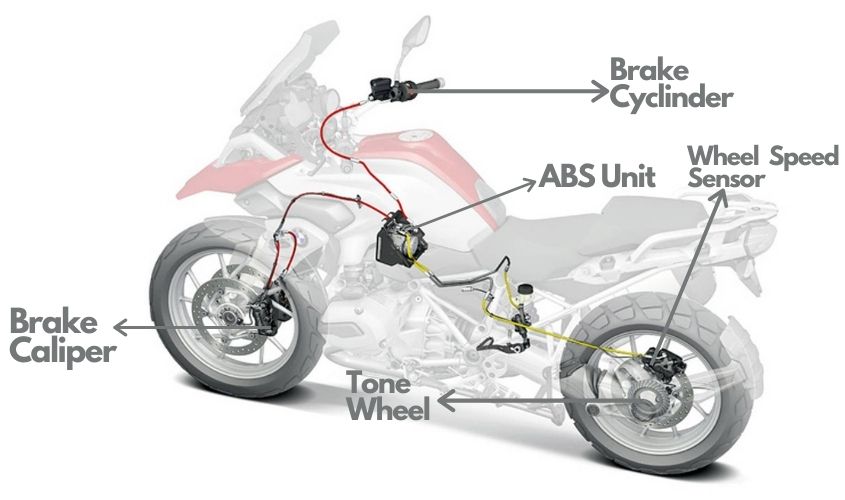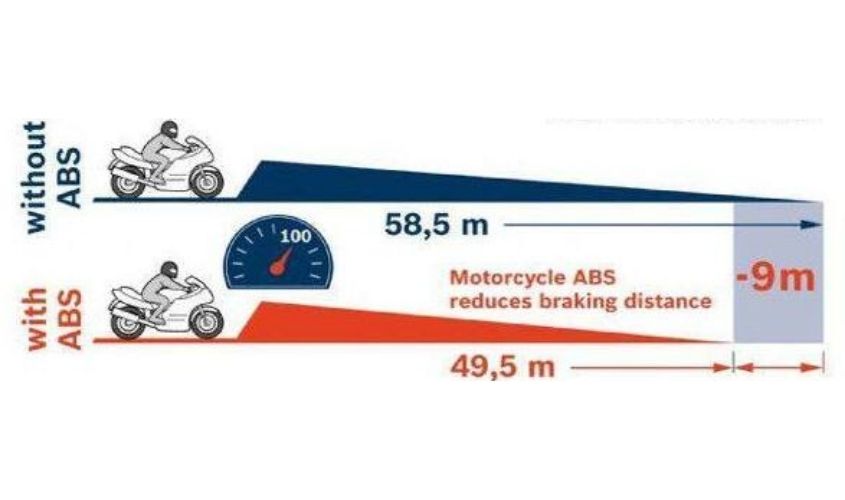
Motorcycle ABS: How does it Work and Why You Must Have It?
"This innovation has the capacity to SAVE LIVES!"
ABS in motorcycle is basically, an anti-lock braking system that provides you with sensors that continuously monitor wheel rotation speed to decide whether a wheel is about to lock up. A series of hydraulic valves alter the braking pressure after detecting a potential lock-up, stopping the wheels from locking up, enabling the wheels to roll, applying and releasing high-frequency brakes. This thwarts the lack of momentum and steering power, allowing the rider more control. ABS brakes can feel like the brake pedal abruptly drop while ABS is functioning well, followed by a fast pulsing feeling. During the time that ABS is triggered, there could be grinding or buzzing noise emanating from the car. As ABS activates, it can also feel like the brake pedal is pulling out.
How does Motorcycle ABS work?

ABS acts to stop the wheel, or wheels, of a motorcycle from locking during braking. As well as sensors to assess whether a wheel is about to lock, ABS uses speed sensors on both wheels to reliably determine wheel speed.
To keep the wheel from locking, ABS changes the brake pressure accordingly and assists in retaining the motorcycle's stability. ABS has been shown to decrease braking distance in many situations. It has been found that motorcycles with ABS technology are involved in fewer road accidents.
ABS in motorcycles can help a rider to reduce speed or to stop his or her motorcycle in an emergency situation. Speed sensors on the motorcycle's wheels monitor the speed of rotation, so the wheels do not lock during braking.
If the wheels are about to lock due to hard braking or slippery road conditions, the ABS hydraulic unit momentarily reduces the brake pressure applied by the rider, so that the wheels continue to rotate. This helps the rider to control the motorcycle and slow down safely.
Motorcycle ABS works by constantly measuring wheel speed, however, it only intervenes to adjust brake pressure if it detects that a wheel is about to stop rotating. A rider shouldn’t notice this at all during normal, non-emergency braking but can be confident that in an emergency they can apply full brake force without the wheels locking up.
Why You Must Have Motorcycle ABS?

You can install motorcycle ABS in your motorcycle and it's simple. If you're serious about installing ABS on your motorcycle, consider your technical skills, and choice for riding first. If you are a beginner, when you are learning how to brake, ABS is outstanding protection.
ABS will usually have shorter managed stopping distance in braking cases where the wheels on a non-ABS fitted vehicle will lock up. ABS braking distance can be longer on certain surfaces, such as asphalt or a skim of snow, but drivers regain the ABS benefit.
The research was commissioned by the Commonwealth and Victorian Governments on the advantages of Anti-Lock Braking Systems (ABS) on on-road motorcycles and published in 2015. It was noticed in the study that:
ABS could reduce 31 percent of death rate and serious injuries from motorcycle accidents. ABS is the standard for just about 20% of new motorcycles. This innovation has the capacity to save 22% of lives from now until 2025 at the current pace of sales of ABS motorcycles. If ABS were made mandatory on all new motorcycles from 2018, this number could grow to 35% of lives saved. So it is definitely worth getting ABS on a motorcycle. A few countries are already in the process of mandating the two-wheeler ABS functionality, and we believe it should also be done in Nepal.
Reviews is conducting a weekly contest. Answer a simple question and get a chance to win exciting gift hampers from Aiken Care Package. Go to our Facebook page for more details or also can check the details on our Instagram page
Also Read:
5 MOTORBIKE ACCESSORIES THAT EVERY BIKER MUST-HAVE
HOW OFTEN SHOULD I GIVE MY MOTORCYCLE FOR SERVICING?
ELECTRIC MOTORCYCLE STARTUP DAMAN ADDS TWO MORE BIKES TO LINEUP
HONDA TO LAUNCH A NEW 200CC MOTORCYCLE ON AUGUST 27
BMW PATENTS RADICAL C EVOLUTION NEW ELECTRIC MOTORCYCLE
REVOLT EXPANDS SALES OF ELECTRIC MOTORCYCLES














